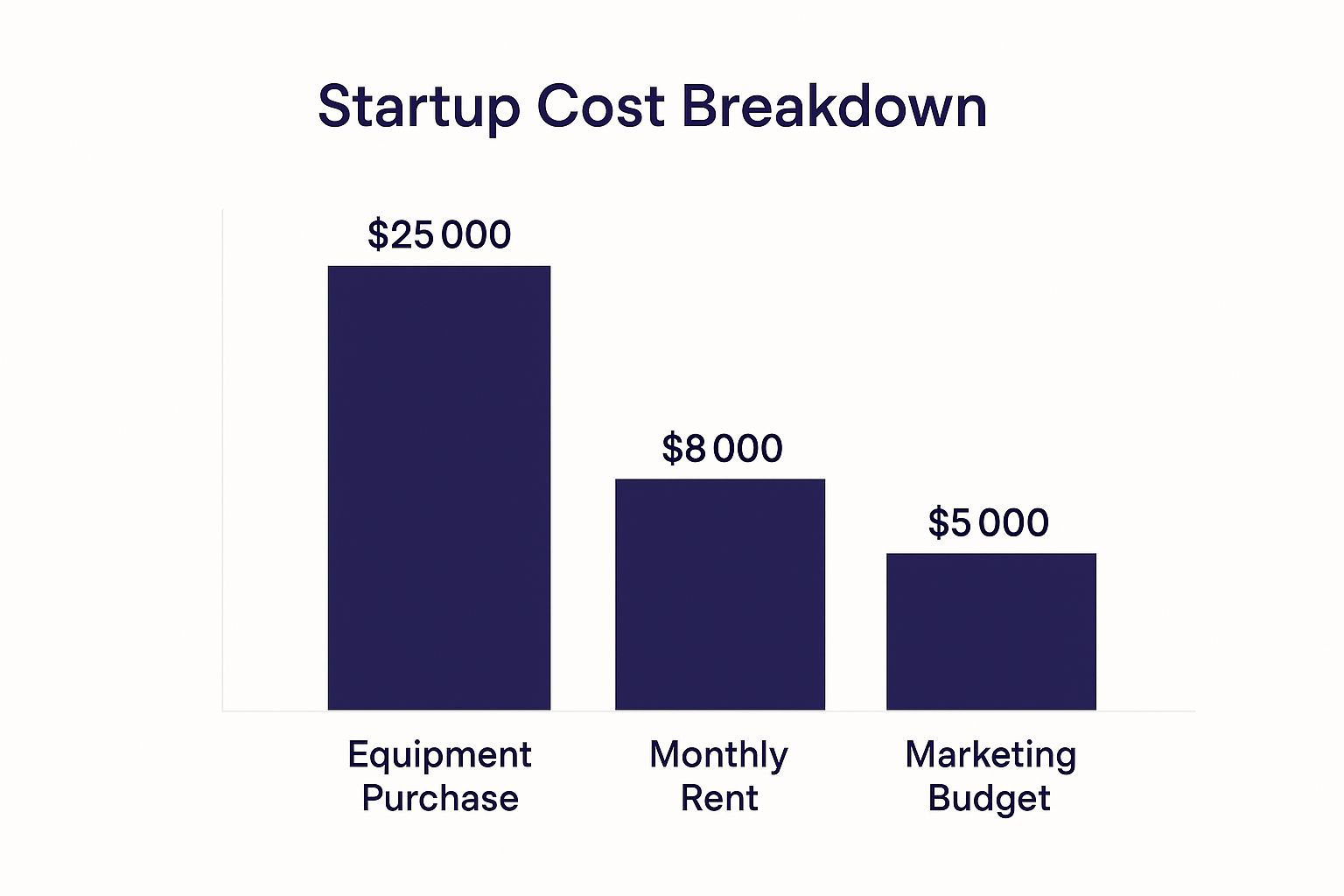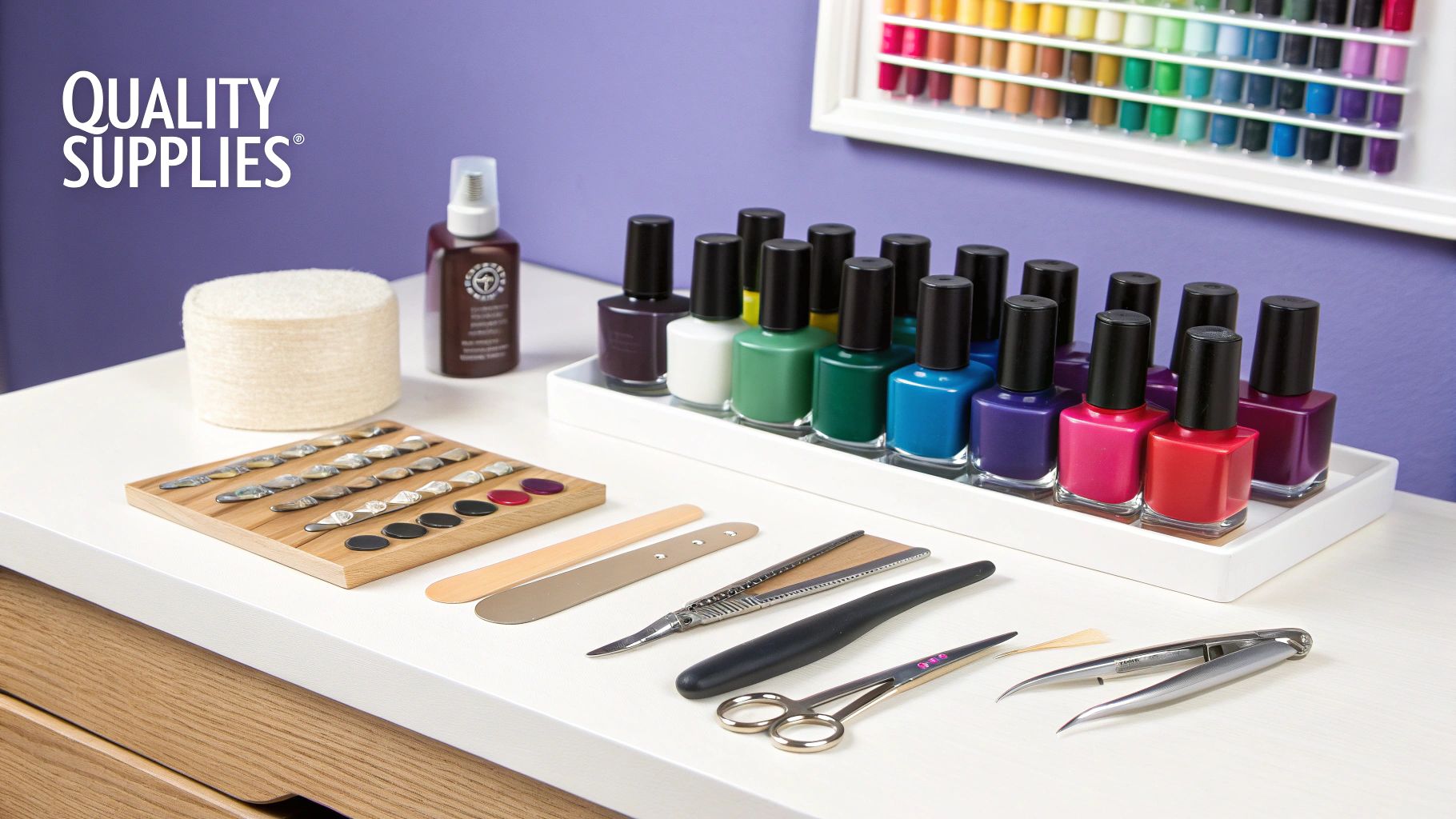How to Start a Nail Salon in 7 Actionable Steps

Before you even think about picking out polish colors, your first and most critical move is to create a solid business plan. This isn't just some stuffy document you write for a bank loan—it's your personal playbook, the GPS that will guide every single decision you make on your journey to becoming a successful salon owner.
Think of it as the blueprint for your dream salon. A great idea is one thing, but a well-thought-out plan is what transforms that passion into a business that actually works and makes money. This is where you get real about the details and set yourself up for long-term success.
Crafting Your Nail Salon Business Blueprint
This initial planning phase is where you give your vision some serious substance. It forces you to think through every nook and cranny of your future salon, from the big-picture vibe to the nitty-gritty numbers. Getting this down on paper helps you spot potential roadblocks early and set clear, achievable goals.
Defining Your Salon's Unique Identity
Let’s be honest: there are a lot of nail salons out there. What's going to make someone walk past three other spots to get to yours? The answer is your unique selling proposition (USP). This is the heart and soul of your brand, the special something that sets you apart. Don't just be another nail salon; be the salon for a specific kind of client.
To take action, consider these concepts to find your niche:
- A High-End Spa Retreat: Picture a zen-like escape focused on luxury, relaxation, and premium services. Think hot stone pedicures, organic scrubs, and champagne on arrival.
- A Trendy Nail Art Studio: This is for the fashion-forward crowd. You'd specialize in intricate, custom designs, the latest nail art trends, and maybe even host guest artists.
- An Eco-Conscious and Vegan Salon: Appeal to the growing market of health-conscious and environmentally aware clients by using only non-toxic, cruelty-free, and vegan products.
- A Quick-Service Express Bar: Perfect for busy professionals. Your focus would be on delivering high-quality, efficient manicures that can fit into a lunch break without sacrificing quality.
Your concept will shape everything—your decor, your service menu, your prices, and how you talk to your customers. Nailing down a clear identity makes it so much easier to attract the right people and build a tribe of loyal fans.
Understanding Your Market and Customers
Once you know what your salon will be, you need to figure out who your clients are and what the local competition looks like. This research is non-negotiable. Start by digging into the demographics of your target neighborhoods. Are they full of young professionals, families with disposable income, or college students?
Next, play detective. Scope out your direct competitors. Go get a service there, check out their pricing online, and deep-dive into their reviews. See what they’re praised for and, more importantly, where they’re dropping the ball. This is how you'll find the gaps in the market that your salon is perfectly positioned to fill. For a wider lens on launching a new venture in this space, check out our complete guide on how to start a beauty business.

As you can see, locking down a great location and investing in quality equipment will likely be your biggest upfront costs. Don't skimp here—these are foundational to your salon's success.
Projecting Your Financial Future
A business plan without numbers is just a daydream. This is where you get down to business and figure out if your amazing salon idea can actually be profitable. You’ll need to map out your startup costs, estimate your ongoing monthly expenses, and project your potential revenue.
The good news? You’re stepping into a booming industry. The global nail care market is expected to rocket from $24.73 billion in 2025 to nearly $35.97 billion by 2032. North America is a huge piece of that pie, valued at $8.65 billion. This isn't just fluff; it's real growth driven by people who love and are willing to pay for professional nail services.
To help you get started, here's a look at the one-time expenses you'll need to budget for.
Initial Startup Cost Estimation for a Nail Salon
A breakdown of potential one-time startup expenses to help you budget effectively for your new nail salon.
| Expense Category | Estimated Cost Range | Key Considerations |
|---|---|---|
| Lease & Renovations | $5,000 – $100,000+ | Includes security deposit, first month's rent, and build-out costs (plumbing, ventilation, flooring, painting). |
| Licenses & Permits | $500 – $2,000 | Business license, cosmetology/salon license, health permits. Varies significantly by state and city. |
| Furniture & Fixtures | $5,000 – $25,000 | Manicure stations, pedicure chairs, reception desk, waiting area seating, display shelves, and lighting. |
| Equipment & Tools | $7,000 – $20,000 | UV/LED lamps, e-files, autoclaves for sterilization, towel warmers, and ventilation systems. |
| Initial Inventory | $3,000 – $10,000 | Polishes, gels, acrylics, lotions, scrubs, files, buffers, cotton, acetone, and other disposables. |
| POS & Booking System | $500 – $2,500 | Hardware (tablet, cash drawer, card reader) and software subscription (like GoHappyBeauty). |
| Marketing & Signage | $1,000 – $5,000 | Exterior signage, website development, grand opening promotions, social media ads, and printed materials (menus, cards). |
| Professional Services | $1,000 – $5,000 | Fees for an attorney to review your lease or an accountant to help set up your books. |
Remember, these are just estimates. Your final costs will depend heavily on your location, the size of your salon, and the level of luxury you're aiming for.
Key Takeaway: Your business plan is your most valuable asset. It transforms your dream into a concrete, actionable strategy, guiding you through the complexities of launching and growing a successful nail salon.
Navigating Salon Licensing and Legal Essentials

Alright, your business plan is looking sharp. Now comes the part that can feel a bit daunting: making your salon a legit, legal business. Think of it less as a mountain of paperwork and more as a series of steps to protect yourself, your brand, and every client who walks through your door.
Getting your legal ducks in a row from day one isn't just a suggestion—it's what separates the pros from the hobbyists. It saves you from massive headaches, scary fines, and legal troubles nobody has time for. This is the foundation you’ll build your entire trustworthy business on.
First things first, you need to officially register your business. This means choosing a legal structure. Lots of new salon owners are tempted to go with a sole proprietorship because it’s simple and the paperwork is minimal. But here's the catch: there's zero liability protection. If your business gets sued, your personal assets—your car, your house—are fair game.
That's why forming a Limited Liability Company (LLC) is almost always the smarter move. An LLC creates a protective wall between your business and personal life. Yes, there’s a bit more paperwork and a small filing fee, but the peace of mind you get is worth its weight in gold-flecked top coat.
Securing the Right Salon and Technician Licenses
Beyond just registering your business name, you've got to deal with industry-specific regulations. The beauty world is heavily regulated to keep everyone safe, and for good reason. You can't just rent a space, buy some polish, and call yourself a nail salon. Every state has a Board of Cosmetology (or a similar governing body) with a list of rules you absolutely have to follow.
Before you even think about opening, you'll need to lock down these critical licenses:
- Salon Establishment License: This one’s for your physical location. It's proof that your salon meets all the state’s requirements for sanitation, safety, and having the right gear, like proper ventilation and sterilization equipment.
- Nail Technician License: This is non-negotiable. Every single person performing nail services in your salon must have a valid, up-to-date state license. No exceptions, ever.
- Business Operation License: This is a general permit from your city or county that allows you to run a business in that area.
- Retail Seller Permit: Planning to sell products like cute cuticle oils or your favorite polish brand? (You should, it's a great revenue stream!) You'll need this permit to legally collect sales tax.
Expert Tip: Don't play a guessing game. Head straight to your state's Board of Cosmetology website. It's your ultimate source of truth and will have a clear checklist of every single thing you need for both your salon and your team.
Why Business Insurance Is Non-Negotiable
Thinking about skipping business insurance to save a few bucks? That’s one of the biggest and most costly mistakes you can make. It's the safety net that protects your entire dream. All it takes is one client slipping on a wet floor or having a bad allergic reaction to a new product to land you in a lawsuit that could shut you down for good.
You'll want a couple of key types of coverage. General liability insurance is your shield against claims of bodily injury or property damage. Think of a client tripping over a pedicure station cord or a polish spill ruining their designer handbag.
Just as crucial is professional liability insurance, sometimes called errors and omissions insurance. This specifically covers you if a client claims your service hurt them, like causing a nail infection or an injury from an e-file. It’s protection designed for the actual work you do.
And as you grow and start building your dream team, remember that employment laws are just as important as your business licenses. To get up to speed, check out a guide to complying with employment laws so you're fully prepared from the start.
Designing a Functional and Stylish Salon Space
Let's be real: your salon's physical space is so much more than just a place to do nails. It’s your silent salesperson, the physical embodiment of your brand, and the backdrop for every single client experience. A killer design isn’t just about looking good—it’s about balancing stunning aesthetics with a practical workflow that makes everything run smoothly.
The second a client walks through your door, they should feel your brand. Are you going for a tranquil, spa-like retreat or a high-energy, artistic studio? Every single choice, from the paint on the walls to the texture of the chairs, works together to create a specific vibe. This is where you bring your business plan to life.
Planning a Smart Salon Layout
Before you even think about shopping for furniture, grab a piece of paper and sketch out a floor plan. Seriously. A well-designed layout is the secret sauce to a smooth-running salon. It’s what keeps your techs from bumping into each other and ensures clients can glide from the waiting area to their service and then to the drying station without a hitch.
Think through the natural flow of a client's visit. Where do they enter? Where will they wait? How do they get to the pedicure stations, and is the path clear and uncluttered? A logical flow prevents those awkward "salon traffic jams" and makes the whole experience feel more polished and professional.
Here are the key zones you need to map out on your floor plan:
- Reception and Waiting Area: This is your salon's first impression. You need a welcoming desk and comfy seating that doesn't feel like an afterthought.
- Manicure Stations: These are your primary money-makers. Make sure there’s enough space for both the tech and client, along with great lighting and proper ventilation.
- Pedicure Chairs: These bad boys need plumbing and a bit more privacy. Try to arrange them in a way that feels relaxing, maybe facing a window or a cool feature wall.
- Drying Area: A dedicated spot with UV/LED lamps where clients can let their polish cure without being in the way of other services.
- Sterilization and Supply Zone: This is your non-public, back-of-house workhorse. It has to be organized and easy for techs to grab sanitized tools and supplies on the fly.
- Restroom: Keep it spotless, well-stocked, and make sure it matches your salon's overall vibe.
Sourcing Essential Salon Furniture and Equipment
Once your layout is locked in, it's time to source the big-ticket items. This is a major investment, so I’m telling you now: prioritize quality and durability over the rock-bottom price. Your pedicure chairs and manicure tables are going to be used all day, every day. They need to be tough.
When it comes to furniture, aim for a mix of comfort, style, and practicality. Look for non-porous materials that are a breeze to clean and sanitize. And don't forget about client comfort! If someone is sitting for a 90-minute service, that chair better be comfortable.
My Two Cents: Functionality should always, always lead your purchasing decisions. A beautiful pedicure chair that’s a nightmare to clean or constantly needs repairs is a liability, not an asset. Invest in equipment that’s built for professional, heavy-duty use.
Beyond the furniture, you'll need an arsenal of professional-grade tools. This is what you'll use to equip your team for success.
Your Essential Equipment Checklist:
- Sterilization Equipment: An autoclave is the gold standard for sterilizing metal tools. It uses high-pressure steam to kill every last microbe. For client safety, this is completely non-negotiable.
- Professional E-Files: High-quality electric files are a must-have for services like acrylics and gels. Don't skimp here.
- UV/LED Curing Lamps: You'll need several reliable lamps to cure gel polishes and extensions quickly and perfectly every time.
- Ventilation System: A proper system to pull chemical fumes and nail dust out of the air is critical for the health of your staff and your clients.
- Towel Warmers: This is a small touch that adds a huge sense of luxury to any manicure or pedicure.
In today's world, a visible commitment to hygiene and safety is a massive differentiator. The global nail salon market, valued at $11 billion in 2022, is projected to hit $20.3 billion by 2030, partly because clients are more savvy about safety standards than ever before. You can dive deeper into these trends at Grand View Research. Salons that shout about their hygiene practices and use modern tools are the ones poised to win.
Assembling Your Dream Team of Nail Technicians

You can have the most stunning salon design and top-of-the-line equipment, but let's be real: the true heart of your business beats within your team. The nail technicians you bring on aren't just employees. They're the artists, the client confidantes, and the very face of your brand. Honestly, figuring out how to build this dream team is probably the most critical part of starting a nail salon.
A fantastic team does so much more than just beautiful nails. They build real relationships, create unshakable loyalty, and turn first-time visitors into regulars who can't stop talking about their experience. This means you need a solid game plan for finding, hiring, and keeping talent that truly gets your salon's unique vibe.
Finding and Vetting Top Talent
Your ideal candidates are out there, but you’ve got to know where to look. Casting a wide net beyond the usual job boards is key to finding technicians who are not only skilled but also genuinely passionate about their craft.
Here’s an actionable recruitment plan:
- Contact Local Beauty Schools: Build relationships with instructors. They can connect you with their most promising recent graduates.
- Scout on Social Media: Search local hashtags (#YourCityNails, #YourCityNailTech) on Instagram. You'll see their work and get a feel for their professionalism and client interaction.
- Use Industry-Specific Job Boards: Post your opening on platforms where professional nail techs are actively looking.
- Network at Trade Shows: Attend local beauty trade shows to meet experienced professionals in person.
Conducting Practical and Insightful Interviews
When you get to the interview stage, you need to go way beyond a resume and a pretty portfolio. Your interview process should be a two-part assessment that checks for both technical skill and personality fit. You need techs who can nail a flawless French manicure and make a nervous new client feel completely welcome and at ease.
First, hold a conversational interview to gauge their passion, communication skills, and customer service instincts. Ask behavioral questions that require real-world examples:
- "Tell me about a time you had to handle an unhappy client. What happened, and what did you do?"
- "How do you keep up with the latest nail art trends and techniques?"
- "In your opinion, what makes for a truly exceptional client experience?"
The second part—and this is the most critical—should be a practical skills test. Ask the candidate to perform a service you plan to offer, like a standard gel manicure or a simple nail art design. This is your non-negotiable chance to see their technical ability, cleanliness, speed, and attention to detail in action.
A Pro Tip: During that practical test, watch their sanitation habits like a hawk. Do they clean their station and sterilize their tools without being told? A deep commitment to hygiene is something you can't compromise on.
Building a Culture That Inspires Loyalty
Finding great technicians is only half the battle. Keeping them is what really builds a powerhouse salon. High turnover is a killer—it's expensive, disruptive, and clients hate it. Creating a positive work environment where your team feels valued and supported is a massive competitive advantage.
It all starts with fair pay. Research what other local salons are offering and choose a competitive structure, whether it's hourly, commission-based, or a hybrid model.
But a great culture is about so much more than a paycheck. Take these steps to build a sense of community and growth:
- Provide Ongoing Education: Invest in your team. Bring in guest artists for a day or pay for them to attend workshops on new techniques. It keeps their skills sharp and shows you’re committed to their careers.
- Encourage Collaboration: Create a vibe where techs share tips and celebrate each other's work. You want a supportive "we're-in-this-together" atmosphere, not a cutthroat, competitive one.
- Listen to Their Feedback: Make time for regular check-ins. Genuinely listen to their ideas and concerns. They're on the front lines and often have the best insights into what’s working and what needs a little tweak.
When your team feels respected, empowered, and happy to come to work, they'll pass that incredible energy directly to your clients. That's how you create the loyal customer base every new salon owner dreams of.
Crafting a Service Menu and Pricing That Actually Makes You Money
Your service menu is the heart of your nail salon. It’s where your creative vision and business smarts collide, so getting it right is non-negotiable. A killer menu doesn't just list what you can do; it tells your brand's story, guides clients to the services they'll love, and, most importantly, keeps your business profitable.
You have to start with the basics—the services every client walking in will expect. We're talking about classic manicures and pedicures. These are your bread-and-butter offerings that build a steady stream of clients. Once you've got that solid foundation, you can start layering in the more exciting, high-margin services that reflect current trends and your unique skills.
Building a Balanced Service List
A smart menu is all about balance. You need a mix of quick, essential services and luxurious, premium upgrades. This way, you have an answer for everyone, from the client who needs a fast polish change on their lunch break to the one who’s ready to splurge on an indulgent spa day with intricate art.
Here's an actionable way to structure your menu:
- Core Services: Think Standard Manicure, Standard Pedicure, and a simple Polish Change. These are your high-volume, lower-priced services that get people in the door.
- Premium Upgrades: This is where you introduce things like Gel Manicures, luxurious Spa Pedicures (with all the fun scrubs and masks), and Paraffin Dips. These are perfect for boosting the value of a standard appointment.
- Advanced Treatments: Now for the showstoppers. This category includes Acrylic Overlays, Gel-X Extensions, and detailed, custom Nail Art. These are your most profitable services because they demand specialized skills and more time, which absolutely justifies a higher price tag.
This tiered approach helps clients easily see their options and gives you natural opportunities to guide them toward more lucrative treatments.
Setting Prices for Profitability
Pricing your services can feel like throwing darts at a board, but it needs to be a strategic decision. Your prices must cover every single cost, reflect your salon’s quality and vibe, and still leave you with a healthy profit. Just peeking at your competitor's prices and copying them is a fast track to financial trouble.
Instead, get down to the nitty-gritty and calculate your cost per service. This isn’t just about the price of polish and cotton swabs. You need to factor in a portion of your rent, utilities, insurance, and the technician's wages for the time that service takes. Once you have that baseline number, you can add your desired profit margin. Then you can scope out the local competition to make sure your prices are in the right ballpark for your market, while still reflecting the premium experience you’re offering.
A hard-earned lesson: Never try to be the cheapest salon in town. Competing on price is a race to the bottom. Clients who only chase the lowest price are never loyal; they'll ditch you the second someone else offers a 10% discount. Compete on value, experience, and killer quality instead.
Boosting Your Revenue Beyond the Manicure
Your menu's money-making potential doesn't stop when the top coat is dry. Smart salon owners are masters at increasing the average spend of every single client. This is where strategic add-ons and a little retail magic come into play.
Try creating service bundles, like a "Manicure & Spa Pedicure" package offered at a small discount. It’s a simple way to encourage clients to book more in a single visit. Loyalty programs are also gold for building a tribe of dedicated regulars who feel appreciated. And please, don't sleep on retail! Set up a small, beautifully lit shelf or corner to sell the products you genuinely use and love—think high-quality cuticle oils, luxurious hand creams, and the polish shades your clients are always asking about.
As you pull your menu together, remember how it looks matters, too. Spending time exploring inspiring menu board design ideas can seriously elevate the customer experience and even nudge them toward higher-priced services. The nail industry is booming, with its global market value projected to leap from $12.01 billion to $13.08 billion between 2024 and 2025. As your salon grows, you’ll need a seamless way to handle all those new clients. A system to book nail appointments online will quickly become your best friend for managing the rush and keeping your schedule packed.
Marketing Your Salon to Build a Loyal Clientele
Your salon is ready, your team is hired, and your polish collection is sparkling. Now for the most important part: filling your appointment book. Effective marketing is what turns your beautiful new space into a bustling, profitable business. This isn't just about placing an ad; it's about building a brand that people are genuinely excited to visit and can't wait to tell their friends about.
A killer launch needs a smart mix of digital savvy and local buzz. The goal is to get in front of your ideal customers where they already hang out—scrolling on their phones and walking around your neighborhood.

Starting with a professional template makes it simple to launch a site that includes a portfolio and booking system. Think of your website as your digital storefront—it needs to make a powerful first impression.
Build Your Digital Foundation
In today's world, if your salon doesn't have a professional online presence, you might as well be invisible. Your website is the cornerstone of all your marketing, and this is where a platform like gohappybeauty really shines. It offers templates designed specifically for beauty businesses, so you're not starting from scratch.
But a pretty site isn't enough. It needs to work for you. Make sure your website includes these non-negotiables:
- A Stunning Portfolio: High-quality photos of your best nail art are a must. This is your visual resume.
- A Clear Service Menu: List your services with detailed descriptions and, most importantly, transparent pricing. No one likes surprises.
- An Easy-to-Use Booking System: Let clients book appointments 24/7. This convenience is a massive selling point and frees you up from answering the phone.
Key Insight: Your website is your always-on receptionist. It should work tirelessly to attract, inform, and convert visitors into booked appointments, even while you sleep.
Master Social Media and Local Search
For a visual business like a nail salon, social media is your best friend. Platforms like Instagram and Pinterest are goldmines for showing off your nail art, your salon's vibe, and your happy clients. Focus on creating crisp photos and short, satisfying videos of the manicure process. For a deep dive, our guide to social media marketing for beauty salons is packed with actionable tips.
At the same time, you have to win the local search game. When someone types "nail salon near me" into Google, you need to be at the top of that list. The first step is setting up a detailed Google Business Profile with your address, hours, photos, and a link to your booking site. Then, gently encourage your first happy clients to leave reviews—positive feedback is jet fuel for your local ranking.
Create Buzz with Opening Promotions
Nothing builds excitement like a grand opening party and some irresistible introductory offers. This initial push is crucial for getting that first wave of clients in the door and creating the word-of-mouth momentum you need. To make sure your launch is a success, check out these proven marketing strategies for new businesses.
Here are a few launch ideas I've seen work wonders:
- Grand Opening Discount: Offer a limited-time deal, like 20% off all services for your first two weeks. It's a low-risk way for new clients to give you a try.
- Referral Program: Give clients a discount on their next service for every new customer they send your way. This is one of the most powerful and cost-effective ways to grow.
- Local Partnerships: Team up with neighboring businesses. Think coffee shops, boutiques, or even real estate agents. A little cross-promotion can go a long way.
Diving into the nail salon world is exciting, but let's be real—it also brings up a ton of questions. If you're wondering about the nitty-gritty details of getting started, you're in the right place. Here are some of the most common things aspiring salon owners ask, with answers straight from experience.
How Much Does It Really Cost to Open a Small Salon?
The startup cost can swing wildly depending on your city, the size of your space, and how luxe you want to go. For a small-to-midsize salon, you should realistically budget somewhere between $40,000 and $150,000.
What does that number actually cover? Think of it as your all-in-one fund for:
- The lease deposit and any renovations needed to make the space your own.
- All the professional gear—pedicure chairs, manicure stations, and essential sterilization equipment like autoclaves.
- Your initial inventory of polishes, gels, acrylics, and other day-to-day supplies.
- The not-so-glamorous but critical costs of licenses, permits, and business insurance.
What Are the Most Important Licenses I'll Need?
Navigating the legal stuff is non-negotiable, and it's where you absolutely can't cut corners. First up, your salon itself will need a state-issued cosmetology or nail salon license. This is for your physical location.
Then, every single person providing services must have their own individual state nail technician license. You'll also need a general business license from your city or county, and if you plan on selling cuticle oil or polish, you’ll need a retail seller permit.
Pro Tip: Don't guess. Your first calls should be to your state's Board of Cosmetology and your local city government. They are the ultimate authority on what's required in your specific area, and they'll save you a world of headaches.
Which Nail Services Are the Most Profitable?
Classic manicures will keep your appointment book steady, but they aren’t where the big money is. The highest profit margins almost always come from your specialized, higher-ticket services.
Gel manicures and advanced extensions, like acrylic or Gel-X, command much higher prices and are fantastic for building a loyal, repeat clientele. And don't underestimate the power of custom nail art! Intricate, one-of-a-kind designs are a high-value service that can seriously boost your bottom line and set your salon apart.
Ready to create a stunning website that brings in clients and makes booking feel effortless? gohappybeauty offers gorgeous, SEO-optimized templates built specifically for ambitious nail salons like yours. Start building your professional online presence today!
Grow your beauty business
Our focus is, and always will be, helping you improve your online presence and generate more business from your website. That is what we do, for you.

